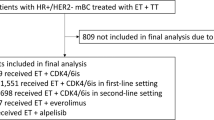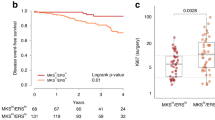Abstract
Background
To identify patients most likely to respond to everolimus, a mammalian target of rapamycin (mTOR) inhibitor, a prospective biomarker study was conducted in hormone receptor-positive endocrine-resistant metastatic breast cancer patients treated with exemestane-everolimus therapy.
Methods
Metastatic tumor biopsies were processed for immunohistochemical staining (p4EBP1, PTEN, pAKT, LKB1, and pS6K). ESR1, PIK3CA and AKT1 gene mutations were detected by NGS. The primary endpoint was the association between the p4EBP1 expression and clinical benefit rate (CBR) at 6 months of everolimus plus exemestane treatment.
Results
Of 150 patients included, 107 were evaluable for the primary endpoint. p4EBP1 staining above the median (Allred score ≥6) was associated with a higher CBR at 6 months (62% versus 40% in high-p4EBP1 versus low-p4EBP1, χ2 test, p = 0.026) and a longer progression-free survival (PFS) (median PFS of 9.2 versus 5.8 months in high-p4EBP1 versus low-p4EBP1; p = 0.02). When tested with other biomarkers, only p4EBP1 remained a significant predictive marker of PFS in multivariate analysis (hazard ratio, 0.591; p = 0.01).
Conclusions
This study identified a subset of patients with hormone receptor-positive endocrine-resistant metastatic breast cancer and poor outcome who would derive less benefit from everolimus and exemestane. p4EBP1 may be a useful predictive biomarker in routine clinical practice.
Clinical Trial Registration
NCT02444390.
This is a preview of subscription content, access via your institution
Access options
Subscribe to this journal
Receive 24 print issues and online access
$259.00 per year
only $10.79 per issue
Buy this article
- Purchase on Springer Link
- Instant access to full article PDF
Prices may be subject to local taxes which are calculated during checkout



Similar content being viewed by others
Data availability
The datasets generated and/or analysed during the current study are available from the corresponding author on reasonable request.
References
Cardoso F, Senkus E, Costa A, Papadopoulos E, Aapro M, André F, et al. 4th ESO–ESMO International Consensus Guidelines for Advanced Breast Cancer (ABC 4). Ann Oncol août. 2018;29:1634–57.
Dodwell D, Wardley A, Johnston S. Postmenopausal advanced breast cancer: Options for therapy after tamoxifen and aromatase inhibitors. Breast. 2006;15:584–94.
Hortobagyi GN, Chen D, Piccart M, Rugo HS, Burris HA, Pritchard KI, et al. Correlative analysis of genetic alterations and everolimus benefit in hormone receptor–positive, human epidermal growth factor receptor 2–negative advanced breast cancer: results from BOLERO-2. JCO. 2016;34:419–26.
Miller TW, Hennessy BT, González-Angulo AM, Fox EM, Mills GB, Chen H, et al. Hyperactivation of phosphatidylinositol-3 kinase promotes escape from hormone dependence in estrogen receptor–positive human breast cancer. J Clin Invest. 2010;120:2406–13.
Saal LH, Holm K, Maurer M, Memeo L, Su T, Wang X, et al. PIK3CA mutations correlate with hormone receptors, node metastasis, and ERBB2, and are mutually exclusive with PTEN loss in human breast carcinoma. Cancer Res. 2005;65:2554–9.
Bachelot T, Bourgier C, Cropet C, Ray-Coquard I, Ferrero JM, Freyer G, et al. Randomized phase II trial of everolimus in combination with tamoxifen in patients with hormone receptor-positive, human epidermal growth factor receptor 2-negative metastatic breast cancer with prior exposure to aromatase inhibitors: a GINECO study. J Clin Oncol. 2012;30:2718–24.
Baselga J, Campone M, Piccart M, Burris HA, Rugo HS, Sahmoud T, et al. Everolimus in Postmenopausal Hormone-Receptor–Positive Advanced Breast Cancer. N. Engl J Med. 2012;366:520–9.
O’Shaughnessy J, Thaddeus Beck J, Royce M. Everolimus-based combination therapies for HR+, HER2− metastatic breast cancer. Cancer Treat Rev. 2018;69:204–14.
Wander SA, Hennessy BT, Slingerland JM. Next-generation mTOR inhibitors in clinical oncology: how pathway complexity informs therapeutic strategy. J Clin Invest. 2011;121:1231–41.
Mertins P, Mani DR, Ruggles KV, Gillette MA, Clauser KR, Wang P, et al. Proteogenomics connects somatic mutations to signalling in breast cancer. Nature. 2016;534:55–62.
The Cancer Genome Atlas Network. Comprehensive molecular portraits of human breast tumours. Nature. 2012;490:61–70.
Treilleux I, Arnedos M, Cropet C, Wang Q, Ferrero JM, Abadie-Lacourtoisie S, et al. Translational studies within the TAMRAD randomized GINECO trial: evidence for mTORC1 activation marker as a predictive factor for everolimus efficacy in advanced breast cancer. Ann Oncol. 2015;26:120–5.
André F. Overall survival (os) results from SOLAR-1, a phase III study of Alpelisib (ALP) + fulvestrant (FUL) for hormone receptor-positive (HR+), human epidermal growth factor receptor 2-negative (HER2–) advanced breast cancer (ABC). Annals of Oncology (2020) 31 :: S1142-S1215 101016/annonc/annonc325. 2020; Disponible sur: https://oncologypro.esmo.org/meeting-resources/esmo-virtual-congress-2020/overall-survival-os-results-from-solar-1-a-phase-iii-study-of-alpelisib-alp-fulvestrant-ful-for-hormone-receptor-positive-hr-human-epi.
Dent S, Cortés J, Im YH, Diéras V, Harbeck N, Krop IE, et al. Phase III randomized study of Taselisib or placebo with fulvestrant in estrogen receptor-positive, PIK3CA-mutant, HER2-negative, advanced breast cancer: the SANDPIPER trial. Ann Oncol févr. 2021;32:197–207.
Vanacker H, Cassier PA, Bachelot T. The complex balance of PI3K inhibition. Ann Oncol. 2021;32:127–8.
Loi S, Haibe-Kains B, Majjaj S, Lallemand F, Durbecq V, Larsimont D, et al. PIK3CA mutations associated with gene signature of low mTORC1 signaling and better outcomes in estrogen receptor–positive breast cancer. Proc Natl Acad Sci USA. 2010;107:10208–13.
Sabine VS, Crozier C, Brookes CL, Drake C, Piper T, van de Velde CJH, et al. Mutational analysis of PI3K/AKT signaling pathway in tamoxifen exemestane adjuvant multinational pathology study. JCO. 2014;32:2951–8.
Loi S, Michiels S, Baselga J, Bartlett JMS, Singhal SK, Sabine VS, et al. PIK3CA Genotype and a PIK3CA Mutation-Related Gene Signature and Response to Everolimus and Letrozole in Estrogen Receptor Positive Breast Cancer. Sotiropoulou G, éditeur. PLoS ONE. 2013;8:e53292.
Memmott RM, Dennis PA. Akt-dependent and -independent mechanisms of mTOR regulation in cancer. Cell Signal. 2009;21:656–64.
Kuo CT, Chen CL, Li CC, Huang GS, Ma WY, Hsu WF, et al. Immunofluorescence can assess the efficacy of mTOR pathway therapeutic agent Everolimus in breast cancer models. Sci Rep. 29. 2019;9:10898.
Capivasertib Doubles PFS in Some Breast Cancers. Cancer Discovery. 2023;13:250.
Howell SJ, Casbard A, Carucci M, Ingarfield K, Butler R, Morgan S, et al. Fulvestrant plus capivasertib versus placebo after relapse or progression on an aromatase inhibitor in metastatic, oestrogen receptor-positive, HER2-negative breast cancer (FAKTION): overall survival, updated progression-free survival, and expanded biomarker analysis from a randomised, phase 2 trial. Lancet Oncol. 2022;23:851–64.
Bertucci F, Ng CKY, Patsouris A, Droin N, Piscuoglio S, Carbuccia N, et al. Genomic characterization of metastatic breast cancers. Nature. 2019;569:560–4.
Razavi P, Dickler MN, Shah PD, Toy W, Brown DN, Won HH, et al. Alterations in PTEN and ESR1 promote clinical resistance to Alpelisib plus aromatase inhibitors. Nat Cancer. 2020;1:382–93.
Bidard FC, Hardy-Bessard AC, Dalenc F, Bachelot T, Pierga JY, de la Motte Rouge T, et al. Switch to fulvestrant and palbociclib versus no switch in advanced breast cancer with rising ESR1 mutation during aromatase inhibitor and palbociclib therapy (PADA-1): a randomised, open-label, multicentre, phase 3 trial. Lancet Oncol. 2022;23:1367–77.
Razavi P, Chang MT, Xu G, Bandlamudi C, Ross DS, Vasan N, et al. The genomic landscape of endocrine-resistant advanced breast cancers. Cancer Cell. 2018;34:427–38.e6.
Prat A, Brase JC, Cheng Y, Nuciforo P, Paré L, Pascual T, et al. Everolimus plus Exemestane for hormone receptor-positive advanced breast cancer: A PAM50 intrinsic subtype analysis of BOLERO-2. Oncologist. 2019;24:893–900.
Bera K, Schalper KA, Rimm DL, Velcheti V, Madabhushi A. Artificial intelligence in digital pathology—new tools for diagnosis and precision oncology. Nat Rev Clin Oncol. 2019;16:703–15.
Espina V, Edmiston KH, Heiby M, Pierobon M, Sciro M, Merritt B, et al. A portrait of tissue Phosphoprotein stability in the clinical tissue procurement process. Mol Cell Proteom. 2008;7:1998–2018.
O’Hurley G, Sjöstedt E, Rahman A, Li B, Kampf C, Pontén F, et al. Garbage in, garbage out: A critical evaluation of strategies used for validation of immunohistochemical biomarkers. Mol Oncol. 2014;8:783–98.
Acknowledgements
We thank Amélie Vermorel and Laetitia Odeyer for their technical expertise, and Drs Lilian Amrein and Yuki Takahashi who provided medical writing services. This study was supported by fund of the Breast Cancer Research Foundation and a research grant to UNICANCER by Novartis.
Funding
This work was supported by R&D UNICANCER. The SAFIR receives financial support from Novartis and the ARC foundation. Data collection, analysis and publication is managed entirely by R&D UNICANCER independently of the funding organizations.
Author information
Authors and Affiliations
Contributions
HV: conceptualisation, investigation, writing–original draft, writing–review and editing. IT: conceptualisation, data curation, formal analysis, methodology, software, validation, visualisation, writing–original draft, writing–review and editing. CS: conceptualisation, data curation, formal analysis, methodology, software, validation, visualisation, writing–original draft, writing–review and editing. IB: conceptualisation, investigation, writing–original draft, writing–review and editing. MC: conceptualisation, investigation, writing–original draft, writing–review and editing. AP: conceptualisation, investigation, writing–original draft, writing–review and editing. MA: conceptualisation, investigation, writing–original draft, writing–review and editing. PHC: conceptualisation, investigation, writing–original draft, writing–review and editing. JPJ: conceptualisation, investigation, writing–original draft, writing–review and editing. FD: conceptualisation, investigation, writing–original draft, writing–review and editing. AP: conceptualisation, investigation, writing–original draft, writing–review and editing. NS: conceptualisation, data curation, formal analysis, methodology, software, validation, visualisation, writing–original draft, writing–review and editing. VA: conceptualisation, data curation, formal analysis, methodology, software, validation, visualisation, writing–original draft, writing–review and editing. ER: conceptualisation, data curation, formal analysis, methodology, software, validation, visualisation, writing–original draft, writing–review and editing. AM: conceptualisation, data curation, formal analysis, methodology, software, validation, visualisation, writing–original draft, writing–review and editing. FL: conceptualisation, data curation, formal analysis, methodology, writing–original draft, writing–review and editing. MJ: conceptualisation, data curation, formal analysis, methodology, writing–original draft, writing–review and editing. FA: conceptualisation, investigation, writing–original draft, writing–review and editing. TB: conceptualisation, investigation, writing–original draft, writing–review and editing.
Corresponding author
Ethics declarations
Competing interests
The authors declare the following financial interests/personal relationships which may be considered as potential competing interests: Mario Campone reports consulting or advisory role with Astra ZENECA, Novartis, Sanofi, Lilly, Pfizer, Gilead, Daiichi-Sankyo, consulting with Pierre Fabre Oncology, Sanofi, Novartis, Servier, Daiichi-Sankyo, PET- Therapy, Diaccurate, travel accomodation with Pfizer, Novartis, Roche, Astra Zeneca Anne Patsouris reports travel accommodation by Roche, Pfizer, ESAI, Lilly, MUNDIPHARMA. Monica Arnedos reports honoraria with Novartis, Pfizer, Gilead, Astra Zeneca, Roche, Astra Zeneca, Daiichi Sankyo and Pfizer (to institution), and travel accomodation with Novartis, Daiichi Sankyo, Pfizer, Lilly, Astra Zeneca. Paul H. Cottu reports consulting role with Pfizer, Roche, Lilly, Pierre Fabre, Novartis, NanoString Technologies, Seagen. Florence Dalenc reports consulting role with DAICHI, AZ, PFIZER, NOVARTIS, SEAGEN and travel/congress support with DAICHI, PFIZER, NOVARTIS, GILEAD. Etienne Rouleau reports consulting role with AstraZeneca, BMS, Roche,Clovis, MSDGSK and Research funding from AstraZeneca. Alain Morel, reports consulting role and research funding with Astrazeneca, GSK, MSD. Fabrice Andre reports stock and Other Ownership Interest with PEGASCY and institutionnal research fundings from AstraZeneca, Novartis, Pfizer, Lilly, Roche, Daiichi, and travel accommodations, from Novartis, Roche, GlaxoSmithKline, AstraZeneca. Thomas Bachelot reports consulting role and institutional research funding from Seagen, Pfizer, AstraZeneca/Daiichi, Novartis, Lilly, and non-financial support from Pfizer, all outside the submitted work. Hélène Vanacker, Isabelle Treilleux, Camille Schiffler,Ivan Bieche, Jean-Philippe Jacquin, Antoine Pinton, Nicolas Servant, valery Attignon, François Legrand, Marta Jimenez declare no conflict of interest.
Ethical approval and consent to participate
This study was approved by an independent Ethics Committee (Comité De Protection des Personnes Sud-Est II-2014 -036 B). All patients provided written informed consent.
Consent to publish
Not applicable in absence of any individual person’s data.
Additional information
Publisher’s note Springer Nature remains neutral with regard to jurisdictional claims in published maps and institutional affiliations.
Supplementary information
Rights and permissions
Springer Nature or its licensor (e.g. a society or other partner) holds exclusive rights to this article under a publishing agreement with the author(s) or other rightsholder(s); author self-archiving of the accepted manuscript version of this article is solely governed by the terms of such publishing agreement and applicable law.
About this article
Cite this article
Vanacker, H., Treilleux, I., Schiffler, C. et al. p4EBP1 staining predicts outcome in ER-positive endocrine-resistant metastatic breast cancer patients treated with everolimus and exemestane. Br J Cancer 130, 613–619 (2024). https://doi.org/10.1038/s41416-023-02549-8
Received:
Revised:
Accepted:
Published:
Issue Date:
DOI: https://doi.org/10.1038/s41416-023-02549-8



